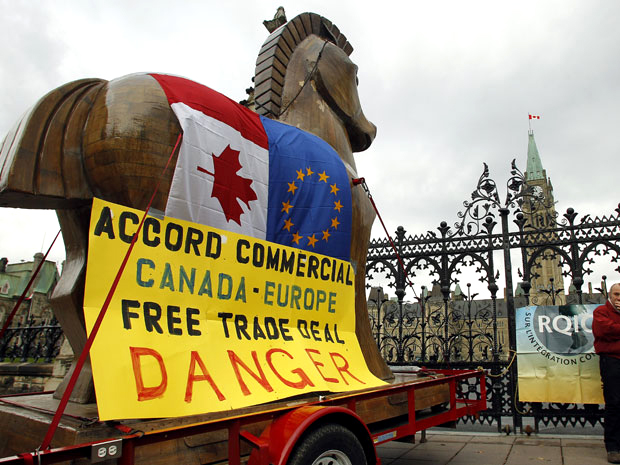Even by the standards of negotiations surrounding the Canada-European Union Comprehensive Economic and Trade Agreement (CETA) the last week of news about the status of the negotiations has been bewildering.
Last Saturday reports surfaced quoting German diplomats in Brussels who stated that that the “German government could not sign the agreement with Canada ‘as it has been negotiated now.'” In the days that followed the report, other German officials distanced themselves from the statement, and indicated that while Germany has concerns over the controversial investor-state dispute settlement (ISDS) process in CETA — which, like NAFTA’s Chapter 11 gives corporations the right to sue governments for policies that may interfere with their profits — that it wasn’t necessarily a deal-breaker.
Less than a week after the report on Germany’s hesitation around CETA surfaced, the CBC reported that “Canada and the European Union will release final details of their mammoth trade deal on Sept. 25 in Ottawa … Multiple sources tell CBC News that the text of the full agreement will be made public by Harper and EU President José Manuel Barroso as part of a formal summit between the two sides. Sources tell CBC News that the signing ceremony will be on Parliament Hill and include other EU leaders attending the summit as well as Canadian premiers.”
That some announcement related to CETA will happen at the September EU-Canada summit in Ottawa is no surprise, and campaigners on both sides of the Atlantic have been looking to the Summit as a key date for months, and especially since July 22 comments by EU Trade Commissioner Karel De Gucht that “I think it should be initialed by the 25th of September when we have the summit with Ottawa.”
So, will CETA be a done deal come September 25? Well … no.
There’s no doubt that Prime Minister Stephen Harper will use the announcement to maximum PR effect, just as he did with the announcement of the agreement-in-principle last October. Of course, the past 10 months of frantic negotiating over substantive issues have exposed that announcement as little more than an attempt to distract attention from the then-swirling Senate scandal.
Perhaps appropriately, the September 25 CETA photo-op will come the week after Mike Duffy’s first court appearance in relation to the scandal.
So, what will we see on September 25? It’s probably easier to start with what we won’t see.
We won’t see a formal signing of the agreement, let alone a conclusion of the process. If — and it’s still an if — the negotiators are able to reach what is called “technical finalization” on the agreement by September 25 there is still a months-long process of legal scrubbing of the text by lawyers on both sides. Following that, there is an official initialling of the scrubbed texts, followed by translation into both official languages in Canada and all 24 official languages of the EU. After that is all complete, the agreement goes to the European Council for signature and then to the 751-member European Parliament for a yes-or-no vote. Only then is the final decision to conclude the agreement made. After that, it will likely also need to be approved by the parliaments, and in some cases regional governments, of all 28 EU member states. This whole process could take years and there are many opportunities along the way for the deal to implode, as has happened before.
And while a final agreement now seems likely, we’ve heard the same thing before … a number of times. Reports indicate that European Union member states will be getting the final (or almost final) text in the next couple days, and have been promised three to four weeks to provide feedback on what’s in the agreement. Presumably, provincial governments in Canada will also be granted a look. We know that a number of countries — not just Germany — are concerned about ISDS being included in CETA, and they could still insist on changes, which could still send negotiators back to the table.
What will we see on September 25?
If it all comes together — and perhaps even if it doesn’t — we’ll definitely see a well-choreographed photo-op on Parliament Hill. And, like last October, we’ll see Prime Minister Harper telling everyone once again that CETA is a done deal. But it wasn’t true then, and it won’t be true on September 25.
The other thing we’ll see, finally, is the text of the agreement. For Canadian citizens, it will be the first time we’ve been able to look at what our government has been negotiating on our behalf since 2009. It will mean for the first time that we’ll be able to point to what’s actually in the agreement, not what leaks reveal or flimsy government summaries tell us is there. After that, there will be months of work to reveal to the citizens of Canada and of Europe all of the problems with CETA, and months more to mobilize the trans-Atlantic movement to ensure that CETA is never ratified.
So enjoy the show on September 25, but remember that it’s not the final curtain.



